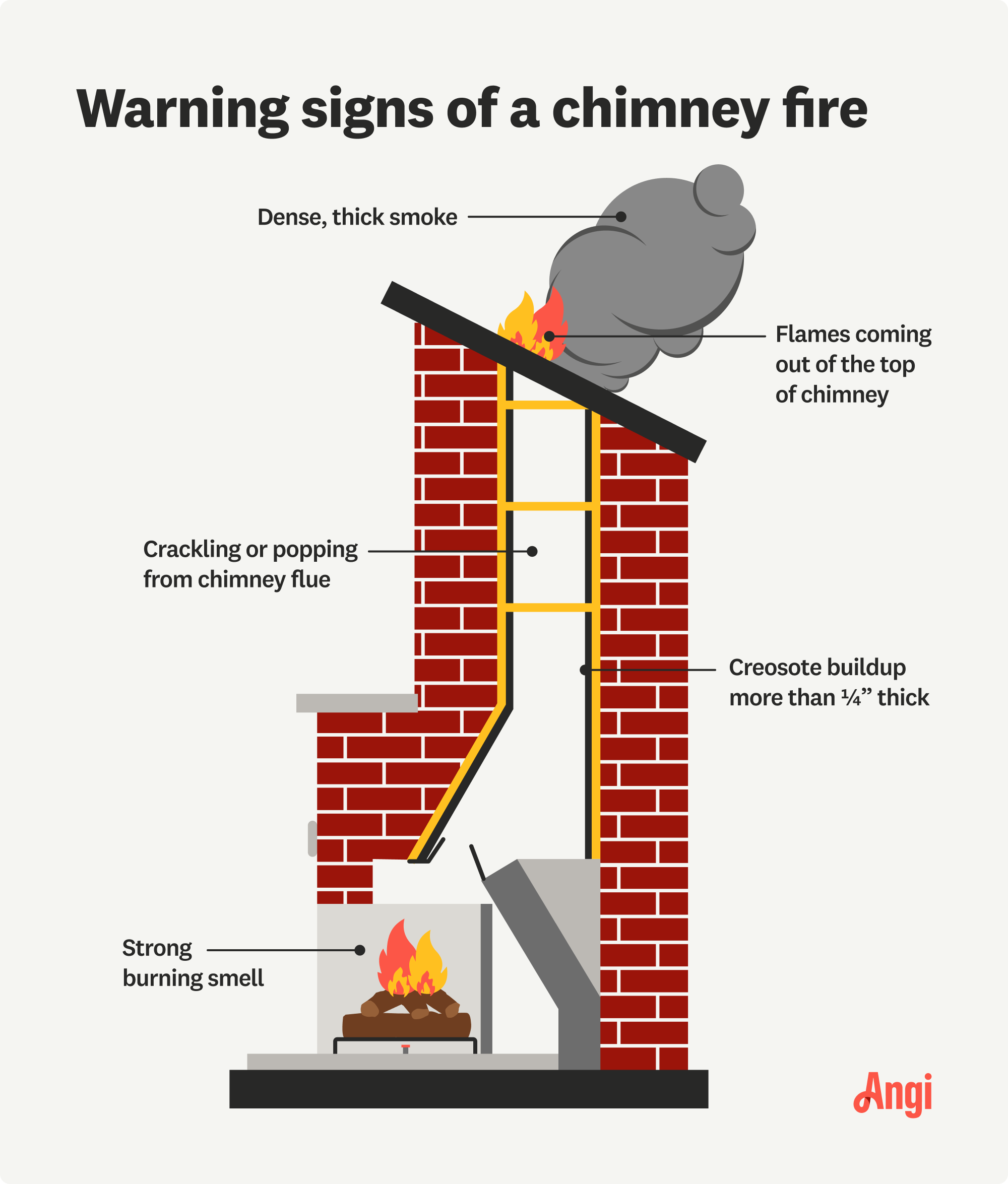
Use our guide to estimate your fireplace repair costs, based on the type of fireplace you have—and what part is broken.
Flames belong in your fireplace—not your chimney


Creosote, a flammable substance created by burning wood, is the top cause of chimney fires.
When enough creosote accumulates in your chimney, it can ignite and set your chimney on fire.
While you can clean light or moderate creosote buildup yourself, it’s safer to hire a pro.
A chimney can also catch fire if there’s something blocking the flue.
Leaves, twigs, branches, bird nests, and animals can all block a chimney flue.
Even though chimneys are designed to withstand heat and flames, they can actually catch fire themselves—and put you in a life-threatening situation. So, what causes chimney fires? Often, it’s a buildup of creosote, but they can start for other reasons, too. Here’s how to prevent those problems so that your chimney doesn’t go up in flames.
Creosote, a tar-like byproduct of wood combustion, is the leading cause of chimney fires. While you burn wood in your fireplace, creosote sticks to the walls of your chimney. If you don’t clean your chimney often enough, the creosote can ignite when the temperature inside your chimney rises.
You can’t prevent a wood-burning fireplace from producing creosote, but you can—and absolutely should—hire a pro to regularly clean the buildup from your chimney.
It’s safest to hire a professional for any type of chimney work, but if you want to remove creosote from your chimney on your own, you have two options:
For light creosote buildup, you can use a chimney brush to scrub the residue from the inside of your chimney.
For moderate creosote buildup, you can apply a chemical creosote remover first, then brush the chimney.

Your chimney flue is the pipe that runs up your chimney and channels smoke and gas out of your home safely. If the flue gets blocked—often with creosote, leaves, branches, or animals—it can lead to a fire inside your chimney.
Again, we recommend hiring a pro for this sort of job—especially if the flue blockage is near the top of your chimney. If that’s the case, you’d have to climb onto your roof to clear it.
If you’re comfortable with that, you can follow these steps to clear a blocked flue:
Put on a protective face mask and safety glasses.
Empty your fireplace.
Cover your floors and nearby furniture with drop cloths.
If the blockage is near the base of your chimney, open the chimney damper and dislodge the debris with a chimney brush. When you finish, close the damper and clean up the mess with a shop vac.
If you’re clearing a clog at the top of your chimney, close the fireplace entrance with a plastic sheet and duct tape. Then, follow the rest of the steps.
Use a ladder to access your roof, being sure to follow ladder safety guidelines.
Remove the chimney cap.
Use a wire chimney brush to push the blockage down your chimney.
Replace the chimney cap.
Use a shop vac to clean up the debris.
As we’ve mentioned, it’s safest to have a professional address these kinds of chimney problems. There are a number of reasons for this, including the health risks of working with creosote and the potential dangers of climbing onto your roof. Plus, if you don’t know what you’re doing, you could accidentally damage your chimney while trying to fix it. For those reasons, we recommend hiring a chimney repair pro near you in situations like these.
Leave all chimney work to a pro. Chimney jobs involve working on a roof, potential exposure to creosote, and ensuring a safe repair or installation of chimney parts. Each of these can be seriously harmful or even deadly for anyone without expertise.

By following some basic fireplace maintenance tips, you can reduce the risk of a chimney fire at your home. These include:
Minimize creosote buildup: There are several ways to keep creosote buildup to a minimum, including using the right type of firewood and maintaining adequate airflow in your chimney.
Install a chimney cap: A chimney cap can prevent leaves, branches, and critters from going down your chimney and starting a fire. Plus, it can keep embers from flying out of your chimney and onto your roof, where they could ignite a fire.
Schedule annual chimney inspections: During a chimney inspection, a professional will thoroughly examine each part of your fireplace and chimney to make sure everything is in good condition and safe to use.
From average costs to expert advice, get all the answers you need to get your job done.

Use our guide to estimate your fireplace repair costs, based on the type of fireplace you have—and what part is broken.

If you’re thinking about installing a new fireplace, you might wonder: How much does it cost to run a gas fireplace? Let’s review the numbers.

The average fireplace installation cost is $2,438, but prices vary depending on the type and size of the fireplace. Calculate your costs with our guide.

Gas fireplaces don’t emit the soothing scent of a campfire, so why not convert? Converting a gas fireplace into a wood-burning one is relatively simple and affordable.

Get those tough soot stains off your brick fireplace by following these easy steps. We’ll take you through the process, step-by-step.

Stone has long been popular for building cozy fireplaces. Check out the top types of stone for fireplaces, from shiny marble to versatile limestone.